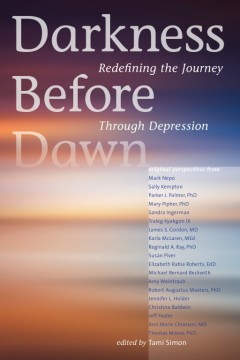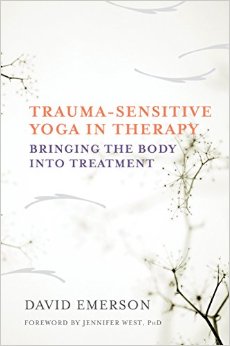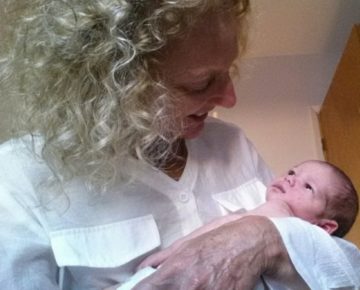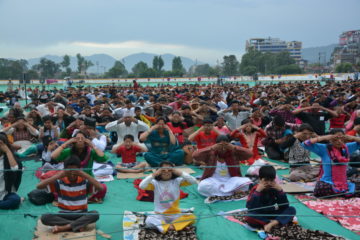
With interest and enthusiasm growing for the evidence-based therapeutic benefits of yoga, not only for mood management, as described in the research article below, but also to reduce inflammation, increase heart rate variability (HRV), increase gray matter in the brain, etc, it is easy to lose sight of why we practice. You may have started your own practice to address a physical or emotional imbalance in your life, but invariably you touch a place in your practice that feels like coming home. In a flash, you understand that the reason you first rolled out your mat, which may have been pain of one kind or another, was a gift. And you are grateful. In that moment, you know that the adversity that brought you to a practice, was the golden key that has unlocked the door to your awakening. What does it mean to awaken? The process is indescribable, painful for some, blissful for others, but the place you arrive is home.
May your practice bring you home.
A warm namasté,
Amy
 RESEARCH: Yoga Best Mood Booster for Breast Cancer Patients
RESEARCH: Yoga Best Mood Booster for Breast Cancer Patients
A complete yoga protocol, designed by a yoga therapist, was compared to supportive therapy, and although both eased symptoms of depression, this study shows that yoga actually did a better job. This study is unusal for two reasons. First, the yoga protocol was delivered and practiced during treatment, while most studies look at yoga delivered post-surgery. Second, the control group was given a form of counseling therapy, defined in the article published in the Indian Journal of Palliative Care in May, as counseling sessions intended to: enrich “the patient’s knowledge of their disease and treatment options,” reduce “any apprehensions and anxiety regarding their treatment and involved interaction with the patient’s spouses,” and create “a supportive environment to facilitate the patients to express their problems, strengthen their relationships in the family and community, and find meaning in their lives.”
The yoga protocol consisted of a ten-minute discussion on the philosophical concepts of yoga and the importance of these in managing day-to-day stressful experiences, twenty minutes of easy yoga postures, yoga breathing exercises, and yogic relaxation. The subjects were then guided through any one of a number of meditation practices for the next 30 minutes. Given the preponderance of depression and anxiety in this population, the study authors chose, in my opinion, excellent meditation practices. Rather than the simple observation of the breath as is most commonly associated with mindfulness practice, they led active practices, giving the depressed/anxious mind, with its tendency to ruminate, something more concrete on which to focus. These focal points included “sounds and chants from Vedic texts, or breath awareness and impulses of touch emanating from palms and fingers while practicing yogic mudras” (hand gestures), “or a dynamic form of meditation which involved practice with eyes closed of four yoga postures interspersed with relaxation while supine, thus achieving a combination of both “stimulating” and “calming,” practices.”
Of the 98 breast cancer patients with stage II and III disease who participated, 45 were randomly assigned the yoga group and 53 began with supportive therapy over a 24-week period. Over the period of the study, participants underwent surgery, followed by radiotherapy or chemotherapy or both. According to the article, subjects were asked to practice yoga for 60 minutes daily with control group undergoing supportive therapy during their hospital visits. If home compliance to the yoga practice was less than 60%, patients were removed from the study. Beck’s Depression Inventory (BDI) and symptom checklist were assessed at baseline, after surgery, before, during, and after RT and six cycles of CT.
A total of 33 yoga and 36 therapy participants completed the 24-week protocol. The results suggest an overall decrease in self-reported depression with time in both groups. However, there was a significant decrease in depression scores in the yoga group as compared to the to the therapy group. The authors conclude that “The results suggest possible antidepressant effects with yoga intervention in breast cancer patients undergoing conventional treatment.”
“Effects of an integrated Yoga Program on Self-reported Depression Scores in Breast Cancer Patients Undergoing Conventional Treatment: A Randomized Controlled Trial,” Indian Journal of Palliative Care. 2015 May-Aug; 21(2): 174–181. doi: 10.4103/0973-1075.156486
Click here to read the full article.
 REVIEW: Darkness Before Dawn: Redefining the Journey Through Depression, Edited by Tami Simon
REVIEW: Darkness Before Dawn: Redefining the Journey Through Depression, Edited by Tami Simon
Reviewed by Deborah Lubetkin, Psy.D., LifeForce Yoga Mentor & Mentoring Director. Learn more about Deborah.
In this riveting compilation of essays on the transformative power of depression, noted authors in the fields of Spirituality, Neuroscience, Yoga, Psychotherapy, Shamanism and more share with profound sincerity their personal journeys through depression. From the very first chapter, I felt my heart open with gratitude for this group of authors who poured out their hearts and souls to help re-frame the experience of depression, or “The Dark Night of the Soul,” as it has been called in so many spiritual traditions.
In one of the first chapters by Karla McLaren, Ed.D., depression is conceptualized as “ingenious stagnation” that provides us with “a vital message about serious problems “ and not the problem itself. She asks, “Where has my energy gone,” and “why was it sent away”? This is one of many, many provocative questions that became, for me a wonderful opportunity for self-inquiry. Throughout the book, depression was reframed in many ways including, but not limited to: a journey, a self-protectivemechanism, a calling, enlightenment, a messenger, a gift, a friend, a portal to waking up, a solution,something to feel intimate with, and most important as a teacher. Many references are made to depression as the “Dark Night of the Soul,” a journey which while deeply challenging is referred to by Chogyam Trungpa as the “most dignified” of all the ego-based states because “it’s the most real and the most accurate.” This Dark Night experience is referred to in most chapters with a consistent re-frame of the Darkness as the “Great Liberator,” which ultimately leads to freedom from the self.
To me this book feels like the experience of talking to a close friend whose presence is felt on a deep level. I love that the Editor included a wide array of authors, including Mary Pipher, James Gordon, Sandra Ingerman, Jeff Foster, Thomas Moore, and our own Amy Weintraub! Amy generously shares her own story through depression which most of you who are reading this already know. But what really came to the surface as I read this book was how profoundly LifeForce Yoga philosophy and practice directly address these ‘Dark Night’ experiences. Whether the Depression takes the form of a chronic low-level type, an Existential type, or the full-out Dark Night experience, the practice of Lifeforce Yoga directly meets the mood and helps us to find our way back to who we really are, beneath this mood. The one type of depression that was not included and would have been a powerful contribution was that of Postpartum Depression. I only wish that this book had been available to me during my own darktimes. I will be recommending it to all of my Mentees, my patients, friends, colleagues, all beings who journey through depression. Most important…I will be recommending it to those who have NEVER been through Depression as I believe that this is a book that has the power to open the eyes of our whole society to this journey of the Darkness Before Dawn.
To purchase a copy of Darkness Before Dawn – please click here.
 REVIEW: Trauma-Sensitive Yoga in Therapy by David Emerson, Foreword by Jennifer West
REVIEW: Trauma-Sensitive Yoga in Therapy by David Emerson, Foreword by Jennifer West
Reviewed by Lonnie DeSorcy, LFYP-II.
When asked to review yoga teacher David Emerson’s most recent book, Trauma-Sensitive Yoga in Therapy, I readily agreed, expecting I would add a few tools to my general yoga therapy / spiritual direction practice. What I didn’t expect was that my world would be turned a little upside down in the process, causing me to pause and consider aspects of my own experience that smack of complex trauma, and leaving me with a deeper sense of compassion both for myself and others.
At times I questioned what seemed to be a significant dilution of the whole tradition of yoga to a handful of practices and even fewer of its philosophical underpinnings to the extent that I wondered why Trauma-Sensitive Yoga (TSY) was being called yoga at all. Yet I was struck by the underlying clarity and compassion with which the TSY-in-therapy model provides a body-based, bottom-up approach that focuses entirely on client empowerment, an extension of the “safe container” expounded by Amy Weintraub, founder of the more traditionally “yoga-like” LifeForce Yoga with which I am familiar.
In contrast to his previous book, Overcoming Trauma through Yoga (co-authored with Elizabeth Hopper, PhD and published in 2011), which covered post-traumatic stress disorder (PTSD) and included chapters for trauma survivors, clinicians, and yoga teachers, this book is aimed specifically at psychotherapists who deal with survivors of complex trauma. While complex trauma was mentioned in the earlier work, in this new volume we see that Emerson has gleaned significant insight into the nature of complex trauma, which he now describes as a markedly tenacious and damaging form of PTSD that stems from repeated interpersonal abuse. Throughout, Emerson paints a lucid picture of the vicious cycle that is particularly evident amongst those who have suffered complex trauma:
trauma –> impact –> maladaptation –> more trauma
Emerson is vitally sensitive to the resulting state of the victim of such damaging on-going and pervasive life circumstance. Trauma-Sensitive Yoga in Therapy applies a yoga-based bodily practice to this incredibly treatment-resistant condition by stripping away all loftier clinical goals and instead building a supportive and invitatory environment in which the client can re-establish, from the ground up, the most basic human capabilities.
Clinician, Dr. Jennifer West, Emerson’s colleague at the Trauma Center in Brookline, Massachusetts, contributed The Foreword to the book. It is a rich addition. She shares research that validates ideas advanced by Emerson and encourages therapists to use this approach because “it directly targets the very symptoms that other approaches struggle to address by using the body purposefully.” Dr. West is clear about the preliminary and mostly anecdotal nature of the current research as it relates to complex trauma and it is evident that more investigation has yet to be done.
In spite of its supple and convoluted evolution, Emerson sees the common denominator of all yoga as “practices undertaken through a desire to live life more fully.” The reader is directed to other sources for more information about the vast tradition of yoga. How TSY is different from main-stream yoga and acts as a treatment for trauma largely rests in how it is presented and that presentation is the subject of the remainder of the text. While it is a form of somatic therapy, TSY differs from Hakomi, sensorimotor psychotherapy and somatic experiencing in that, like LifeForce Yoga, it does not try to make meaning out of bodily experience but rather offers an opportunity for the client to simply have an experience in the body. Emerson provides ample support for the overriding goal of allowing a client to experiment with empowered embodiment in a safe, relational environment by highlighting concepts from trauma theory, neuroscience of trauma, and attachment theory.
In light of those scientific paradigms and his own experience, Emerson explains that typical victims of complex trauma are unable to feel their own bodies or otherwise not trust their own bodily experience. They have lost the sense of agency – that they have much or any control over their situations or actions. Further, they typically experience significant difficulty trusting and connecting with people around them. There is a hidden and arbitrary quality to things that will set them off – their triggers. As in LifeForce Yoga applied clinically, the fundamental task of a therapist using TSY, then, is to use the therapeutic relationship as a primary source of healing by creating a safe container in which yogic “forms” are the context to put the client in the driver’s seat, providing opportunities for clients to feel their bodies in new and safe ways and empowering them to take the lead. Throughout, a deep sensitivity to the client’s experience is critical. Specifically, the key objectives of TSY are to use a shared, authentic encounter with the therapist, to have the client progressively:
- notice sensation or lack thereof in a particular area of the body
- make self-motivated choices at every possible opportunity
- take action with intention, then with purpose, and perhaps see action in light of its effectiveness,
- be present
- use parallel self-directed rhythm to connect interpersonally with the therapist and experience that all things have a start and a finish
In TSY, yoga poses are called “forms” to avoid the negative connotation of “posing” for a perpetrator as well as the tendency of trauma survivors to externalize experience. Attending to breath is a chance to experiment with options; breath awareness itself can be a very significant undertaking for a survivor of complex trauma; so, unlike LifeForce Yoga, TSY makes no attempt at breath- or subtle-energy control (pranayama) to alter mood or energy using some known effect of a certain type of breath. In TSY, “mindfulness” is limited to the felt-sense of the body, not of the heady content Emerson believes is found in mainstream yoga and what he calls “New Age” practices such as mindfulness meditation. This is in contrast to LifeForce Yoga which certainly starts with specific attention to sensation in a certain part of the body but, for example, at the discretion of the therapist and option of the client, sometimes continues to a non-dual practice that has a cognitive component. In both systems, language is invitatory, collaborative and carefully chosen; but in TSY it never is used to prescribe, direct, praise, teach, explain or elicit. Thus, TSY, unlike LifeForce Yoga, excludes using imagery, intention-setting, kriya, movement, breath, non-dual or any other practices that intend to regulate mood or shift perspective.
Additionally, Emerson has shifted from a cautionary stance toward the use of touch in his previous work to an absolute prohibition of it in Trauma-Sensitive Yoga in Therapy because he has never seen a clinical case of complex trauma in which touch has been a positive experience for the individual. I notice he has not cited a standardized trial regarding this and my sense is that therapists will use their own judgement as to whether they will give clients the choice to accept supportive touch. Where Overcoming Trauma Through Yoga deliberately provided tips on how to match yoga-based interventions to therapeutic goals (including mood regulation) this newer book pointedly eliminates practices aimed at managing affect or energy. When the TSY practice reaches an impasse such as when the client cannot tolerate any more interoception and is having difficulty self-regulating, Emerson directs the therapist-reader to resort to something other than TSY. Here, a psychotherapeutic methodology or a LifeForce Yoga practice would meet his instruction to access literature on “using breath and posture to change cortisol and testosterone levels in the body in order to calm down and feel more competent” (p57).
Especially in the practice section of the book, Emerson vacillates without warning between speaking to therapist and then to victim. Further, whether Emerson intends the material to be applied in one-on-one clinician-client scenarios, group therapy, or both is not clear. Beyond what I have already stated, suggestions are not made as to when a client might take part in an increasingly wider world of helpful yogic practices such as specific breath, imagery, intention, kriya, or other movement as deemed appropriate to meet and balance the mood. I surmise that clinicians who are trained in a system such as LifeForce Yoga would guide their client through such a transition as they see fit.
Notable in this new volume is the portfolio of yoga forms, each on a single page, specifically meant for the clinician’s office. They all are chair-based, fully illustrated and complete with suggested scripting. They are meant to be photocopied for easy therapist reference. This is a definite improvement over the therapy chapter in the earlier book, but the reader should be prepared to have a working knowledge of the rest of the contents, including self-practice of the material, in order to use the portfolio appropriately.
Trauma-Sensitive Yoga in Therapy exemplifies what many of us helping professionals have come to know: less can be more. Cultivating an atmosphere of invitation and empowerment and responding with the utmost sensitivity to client cues, the therapeutic clinician empowers the individual to once again feel, choose, act intentionally, discriminate, and experience safe connection using as the context simple “forms” that look like yoga. It is particularly instructive in creating the safe container. The result is a starting place, consistent with Emerson’s final introductory statement, “. . . when the truth is finally felt and acknowledged in the body, survivors can begin their recovery.”
To order a copy of Trauma-Sensitive Yoga in Therapy – please click here.
 Reviewer: Lonnie DeSorcy, LFYP-II
Reviewer: Lonnie DeSorcy, LFYP-II
Lonnie DeSorcy offers intimate yoga classes and private spiritual direction in Calgary, Alberta, Canada. Her passion is a small yoga therapy practice in which she holistically collaborates with clients to create individualized programs “to grow through life joyfully”. Lonnie’s professional background includes the military, social work and IT management consulting but over the last twenty years she has focused on yoga and other wellness modalities, becoming a senior teacher (800+hrs, 15+yrs) with the Yoga Association of Alberta and graduating from Mount Royal University’s inaugural Yoga Therapy class. Lonnie likes to delve deeply into the mechanisms that underlie the efficacy of this tradition that has helped her to negotiate life’s substantial twists and turns. Supplementing regular study with teacher, David McAmmond, Lonnie undertakes many professional development opportunities in yoga, vipassana meditation, spiritual direction and complementary medicine. A highlight has been LifeForce Yoga®. She received her LFYP-II in 2013. Contact: Lonnie@YogInsight.com.
 REVIEW: Yoga Therapy: Theory and Practice, Edited by Ellen G. Horovitz and Staffan Elgelid
REVIEW: Yoga Therapy: Theory and Practice, Edited by Ellen G. Horovitz and Staffan Elgelid
Reviewed by Sherry G. Rubin, LCSW, E-RYT, LFYP-II. Learn more about Sherry.
As a result of their dedication and hard work, leaders in the field of yoga and yoga therapy join together in this book to write about how they define, refine, practice and research the many benefits of yoga. Twenty dedicated yoga, medical, mental and other healthcare providers offer wide ranging and important information in these pages. Anyone interested in learning more about the history, application, depth and variety of yoga therapy, and certainly yoga teachers and health care providers, will want to read this book.
The roots of yoga are ancient while its practice, application and availability are widespread, growing and live side by side with current medical and psychological healing practices. Yoga first found me by chance when I visited a friend’s brother in a halfway house. A few years later it took some searching to find somewhere relatively close to me to learn yoga. Today, the small town in which I live is also home to three yoga studios within less than a mile of each other. I marvel at the growth and changes as well as the opportunities and challenges this popularity offers. Authors in this book address yoga philosophy, history, and are helping to shape a healthy present and strong future for yoga through their contributions.
The first section describes the history, philosophy and regulation of yoga therapy. The four chapters set the foundation for understanding how practices have developed as well as how the stewards of yoga are rigorously defining and researching the practices to bring an evidence base to Yoga Therapy. Adhering to scientific standards allows us all to offer yoga therapy or integrate yoga into our clinical practices with support and confidence.
The second section, the major part of the book, is devoted to describing models of practice. Most of these chapters address the impact of stress and trauma on the autonomic nervous system and elucidate how various yoga practices, particularly breath and meditation, are used for self-regulation and healing. Other than these thematic similarities, chapters offer information about different approaches and models of yoga as therapy. At the end of each chapter the authors offer suggestions for self-inquiry or questions to guide the reader in thinking about the content presented. Extensive references that could lead you on a comprehensive educational journey are provided at the end of each chapter.
I am tempted to offer many fascinating facts I learned from each of the authors, but that would only make this review another book. Each contributor describes the connection between what they offer and the tradition of yoga. If you are interested in appreciating the scope and depth of yoga practices, each chapter will serve as a review of the underpinnings and rich history as well as current practice and research.
The book contains much important and useful information… from neuroscientific explanations of the autonomic nervous system and stress responses from Richard Brown and Patricia Gerbarg; to Judith Lasater’s use of restorative yoga, specifically savasana, to produce the relaxation response; from Ellen Horovitz’s fascinating combination of art, family and yoga therapy; to Amy Weintraub’s insightful chapter describing “the crumbling wall” between yoga and mental health, and how essential it is to bring the body into mental health treatment. The autonomic nervous system, stress, compassion fatigue and burnout were discussed in a few chapters, highlighting the need to use the gifts of yoga for our own self-care as therapists and caregivers.
Anyone who practices or offers yoga as healing will appreciate and learn a lot from this book. To order a copy of Yoga Therapy – please click here.
 FREE EVENT: Coloring Outside the Lines -Free Parenting Telesummit
FREE EVENT: Coloring Outside the Lines -Free Parenting Telesummit
You’re invited to listen in on the Coloring Outside The Lines interview series for free!
Lianne Dixon, a Life and Family Coach invited me to join a panel of 20+ experts who will present their thoughts on the latest heart-centered approaches that parents can easily incorporate. Because you are on our newsletter list, you can listen in on this interview series for free if you register at the link below:
Click here to learn more and register for free!
The summit experts will discuss how you can connect with your children on an emotional, mindful and spiritual level and introduce you to innovative methods of nurturing your children so they can become responsible, caring and generous adults who honor your relationship and look forward to time spent with you.
Frequently, parents who follow traditional parenting approaches (or parents who lack a strategy) come to a crossroads in childhood development where communication becomes difficult and the ability to provide guidance fades away.
During this event, you’ll discover the benefits of a deeper connection with your child and find ways to create unique, happy, and memorable family moments and learning experiences that will help promote deeper connections and healthy development.
I encourage you to join me and listen in on this 20+ interview parenting series.
 APPEAL: Donate for Nepal Earthquake
APPEAL: Donate for Nepal Earthquake
Senior Yoga researcher and pioneer in the field, Dr. Shirley Telles has alerted us to the ways Patanjali Yogpeeth is supporting survivors in Nepal and how we, in the West, can help them in their efforts.
“Please do not feel pressurized by this appeal. We all have our commitments and if you cannot help at this stage, I can fully understand. Your good wishes are important as well”
Dr Shirley Telles
Director of Research
www.patanjaliresearchfoundation.com
Part of Patanjali Yogpeeth.
As Nepal grapples with one of the worst natural disasters in its history Patanjali Yogpeeth is using two of its establishments in Nepal to house the homeless while providing food and water to those in need. It has further pledged to adopt and care for at least 500 orphaned children.
Donations to the appeal will be used directly to continue with this work.
FOR DONORS FROM OVERSEAS
State Bank of IndiaBranch: B.H.E.L., Sec- 5, Ranipur, Haridwar
A/C holder: Patanjali Yogpeeth (Trust)
Bank Account No. 30523427810
SWIFT Code: SBININBB225
E-mail: divyayoga@divyayoga.com
or donation@divyayoga.com
Ph. 01334-240008
Events Calendar
Visit our Event Calendar to find a Yoga for Mood Management Training or Workshop near you!
Wonderful book reviews! I thoroughly enjoyed the thoughtful reflections.